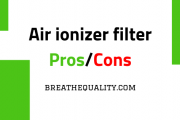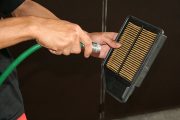To determine the strength of an electronic device, we always look for all the common specs. For an air purifier, two of the things we have heard the most about are the CADR rating and ACH rating. So what is CADR rating? What is an ACH rating? You may have asked these questions many times before purchasing any air purifiers, right?
However, the answer is really simple.
Air purifiers are becoming increasingly popular. People who suffer from allergies or asthma will no longer have to suffer in silence, as an air purifier is one of the most effective ways to prevent allergies and asthma. Because of that, we will see more and more air purifiers used at home and in other public places like schools, hospitals, or healthcare services. So are you ready to find out what a CADR rating is and pick the right air purifier for you? Let Breathe Quality help you.
Note: If you need an answer to a common question about air purifiers, please read our air purifier FAQs.
Air Purifier Definitions:
What is CADR rating?
CADR stands for “Clean Air Delivery Rate.” In general, this numerical value will show you exactly how much of the specific particles to be removed from the air. In other words, the CADR rating indicates how fast the air purifier can clean the air within a particular size room. For example, an air purifier with CADR rating of 300 cfm will clean a room of 300 sq ft much faster than an air purifier with CADR rating of only 200 cfm.
CADR rating is taken in CFM, which stands for cubic feet per minute, or in m³/hour. CADR measurements are usually for pollen, smoke, and dust. These three pollutants are not only small in size but also the most unwanted particles in the air. Smoke particles are ultra-fine particles, with defined particle sizes ranging from 0.1 to 0.3 microns. Dust particles are common particles with sizes ranging from 0.5 to 3 microns. And pollen particles are the large particles that you can see with your own eyes, with sizes ranging from 5 to 11 microns.
CADR ratings were invented by the AHAM (Association of Home Appliance Manufacturers). It is safe to say that AHAM’s CADR rating is currently the most accurate measurement. To make use of the CADR rating, you can look for it whenever picking an air purifier. The better the CADR ratings are, the more powerful this air purifier’s fan is.
Expert tip: Remember that CADR ratings only show the cleaning capacity, not the cleaning capability.
It means that an air purifier with a high CADR rating has enough fan power to cover a large room.If you want to know the cleaning capability, you should check the filters and the technology of this air purifier. Knowing that you don’t have time or experience to test all these specs, Breathe Quality was born to help everyone check all the air purifiers with absolute authenticity.
Up until now, here are our trusted lists of the best air purifiers at the moment (always up-to-date):
- 1, Best Air Purifier (Air Purifier Ranking List)
- 2, Best Air Purifier for Allergies
- 3, Best Air Purifier for Bedroom
- 4, Best Air Purifier for Baby
- 5, Best Air Purifier for Smoke
- 6, Best Air Purifier for Dust
- 7, Best Air Purifier for Mold
- 8, Best Large Room Air Purifier
- 9, Best Air Purifier for Pets
- 10, Best Air Purifier for Office
How to measure CADR ratings?
CADR ratings are strictly determined by an ANSI/AHAM AC-1 test. This test is simple to use but extremely accurate. The testing agency will put the testing air purifier unit into a chamber with a determined amount of contaminants. After 20 minutes of running, they stop the air purifier and measure the air in this chamber again. Finally, they can draw conclusions about the CADR ratings for this air purifier.
However, this test has its own limits. CADR ratings are only for specific contaminants, in this case, dust, pollen, and smoke. If you need an air purifier for a specific kind of virus or bacteria, AHAM’s CADR ratings are just not useful. Furthermore, the short 20-minute test is a clear limit of this test, as some air purifiers work fine for the first 20 minutes but then decline in performance rating later.
Also, the ionizer is one reason for making CADR ratings false. Ionization is the process of sticking many small particles into a bigger one without trapping them. Usually, these bigger formed particles are dropped on the floor and wall. Without proper removal, these pollutant particles are ready to be in the air once again.
At the moment, we guess you understand the limits of CADR ratings. While this measurement is one key factor in choosing the right air purifier, keep in mind that you should test other specs as well. An expensive air purifier will always be better than a cheap one, even when it has a lower CADR rating. That’s mostly because they are using a higher-quality filtration system.
What is ACH? Is ACH related to CADR ratings?
ACH stands for “Air Changes per Hour”. The ACH rating indicates how many times per hour an air purifier device can exchange the air within a room. More fresh air exchange means better air quality in general.
Together with CADR ratings, the ACH rating shows exactly the power of this air purifier fan. In short, a 5X ACH air purifier will clean a specific volume more times than a 2X ACH air purifier.
If you want to know how ACH is related to CADR ratings, let’s look at the example below:
You have a Honeywell HPA300 with an average CADR of 300 cfm. This air purifier can run as high as 5X ACH. So, how big of a room can the Honeywell HPA300 clean effectively?
Well, within 1 hour (or 60 minutes), the Honeywell HPA300 can clean a capacity of 300 x 60 = 18000 cfm.
With a typical 8-foot ceiling height, you’ll get: 18000 (cfm)/8 (f) = 2250 (f2.h).
Divide this value by the ACH, and you will have the answer: 2250 (f2.h)/5 (h) = 450 f2. Well, in the manual, Honeywell HPA300 is claimed to be effective in a room size of 450 sq ft.
We hope, up until now, you fully understood “what is CADR rating” and “what is ACH.” Don’t forget that you can put full trust in Breathe Quality’s air purifier test. To give you one list, we need to test hundreds of air purifiers on the market.
Rating Breathe Quality
-
Average ratings for this post



